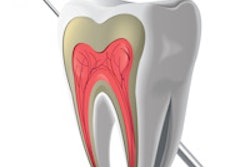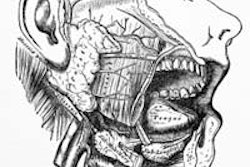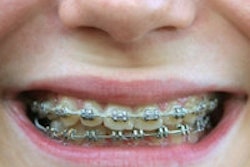
A patient receiving antiresorptive therapy for the prevention and treatment of osteoporosis has a low risk of developing osteonecrosis of the jaw (ONJ), and benefits of the medication outweigh the risk of ONJ, according to an advisory statement from the ADA.
The statement, "Managing the Care of Patients Receiving Antiresorptive Therapy for Prevention and Treatment of Osteoporosis," is based on a literature review by an advisory committee of the ADA Council on Scientific Affairs and updates ADA's 2008 advisory statement (Journal of the American Dental Association, November 2011, Vol. 142:11, pp. 1243-1251).
ONJ associated with antiresorptive agents has mostly been referred to as bisphosphonate-associated ONJ, but nonbisphosphonate antiresorptive agents are now available that also could be associated with ONJ, the panel noted. That is why they refer to the condition as antiresorptive agent-induced ONJ (ARONJ).
A relatively new condition, bisphosphonate-associated ONJ, has received tremendous media attention because of a flurry of lawsuits against the makers of Fosamax and Zometa alleging that the medications led to ONJ.
These lawsuits have been a factor in raising patients' and dentists' awareness of the condition, according to Helen Ristic, PhD, director of scientific information for the ADA's Division of Science and one of the panelists who contributed to the report.
“The risk for developing ARONJ remains unknown despite attempts at quantification.”
— Helen Ristic, PhD
"The first calls the ADA received from dentists about ARONJ were in response to advertisements by lawyers and media reports," she said.
Still, much about the condition remains a mystery, in part because there has not been enough clinical research, she and her co-authors noted.
"The risk of developing ARONJ in a patient who does not have cancer appears to be low, with the highest prevalence estimate in a large sample of patients about 0.10%," they wrote. "At present, there are no published studies that adequately address incidence. The few studies published to date involved the use of a wide range of methods, all with potential shortcomings, and the incidence estimates reported varied."
Without good information about the incidence of ARONJ, it is difficult to predict risk in general, and it is impossible to predict a specific patient's risk, they added.
"The risk for developing ARONJ remains unknown despite attempts at quantification," Ristic explained. "Study limitations such as small sample size, retrospective design, inadequate study duration, and issues associated with voluntary reporting of cases have hindered accurate estimation of incidence and prevalence in the general population."
Key recommendations
The ADA updated these guidelines to help dentists make treatment decisions based on the current best evidence when available and expert opinion when necessary, the authors noted.
To gather clinical data for the report, they searched Medline for literature published between May 2008 (the end date of the last search for the 2008 advisory statement) and February 2011. The authors also searched the Cochrane Central Register of Controlled Trials.
|
Some facts about ARONJ Antiresorptive agent-induced ONJ (ARONJ) is commonly associated with dental procedures and conditions that increase the risk of experiencing bone trauma. While many cases of ARONJ have been associated with an invasive dental procedure such as tooth extraction, ARONJ also occurs spontaneously or in patients with minor mucosal irritation, such as those who wear dentures, according to Helen Ristic, PhD, director of scientific information for the ADA's Division of Science. Other factors associated with increased risk of developing ARONJ and other types of ONJ include the following:
|
The guidelines contain recommendations about managing at-risk patients for periodontal disease, implant placement and maintenance, oral and maxillofacial surgery, endodontics, restorative dentistry and prosthodontics, and orthodontics, and also discusses the effectiveness of CTX testing and drug holidays.
Key recommendations include the following:
- Discontinuing bisphosphonate therapy may not lower the ARONJ risk; however, it may have a negative effect on low bone mass treatment outcomes.
- Routine dental treatment generally should not be modified solely due to use of antiresorptive agents.
- An oral health program consisting of sound oral hygiene practices and regular dental care may be the optimal approach for lowering the ARONJ risk.
- Patients who are prescribed antiresorptive agents and are not receiving regular dental care would likely benefit from a comprehensive oral examination before or early in their treatment.
- Screening tests intended to predict risk have not shown reliability or accuracy in predicting risk for ARONJ. Therefore, serum testing is not recommended to predict risk.
"Because of a paucity of clinical data on the dental management of patients on antiresorptive therapy, these recommendations primarily are based on expert opinion," Ristic said. "They are intended to help dentists make clinical decisions and should be considered with the practitioner's professional judgment and the patient's preferences."
What dentists can do
Discontinuing bisphosphonate therapy may not lower the risk of ARONJ but may have a negative effect on low bone mass treatment outcomes, and that is why significant dental risks need to be present to consider cessation of antiresorptive therapy, the panel noted.
When a patient on antiresorptive therapy who could be at risk for ONJ comes in for an invasive dental procedure, a discussion of the risks and benefits is appropriate, Ristic said.
"The patient should be informed of the dental treatment needed, alternative treatments, how any treatment relates to the risk of ARONJ, other risks associated with various treatment options, and the risk of foregoing treatment, even temporarily," she said.
A closer collaboration between dentists and physicians may be of benefit to patients at risk, according to Ristic.
"Dentists should encourage patients to consult with his/her physician about health risks associated with discontinuation of antiresorptive therapy," she said. "All decisions with respect to utilization of drugs prescribed for medical conditions should be discussed with the prescribing physician."
Misinformation and misunderstandings can lead to severe and preventable adverse events, she warned.
"Efforts should be made to present a balanced assessment of the current information to the patient," she concluded. "A collaborative approach between dentists and physicians may be the best way to accomplish these goals."



















